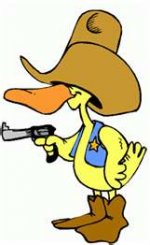The secondary sight line is looking at the fractions on the OB and unlike GB, where for cut angles greater than 30 degrees, the point of aim is off of the edge of the OB on to the cloth.
Since there is no relationship to the contact/impact point on the OB and that the resulting cut angles will be different depending on the shooters bridge distance behind the CB, eye/s dominance and perhaps the diameter of the ferrule, These cut angles must be commited to memory as they relate to the secondary sight lines to the corresponding fraction on the OB.
One then looks at the shot at hand and recalls what the secondary aim line is.
Anyone should be able to do this if they are inclined to do so.:thumbup:
This is a good example of not fulling understanding how ghost ball works.
The point of aim is always 1/2 cb from the outer most edge of the ob and never the contact point. This 1/ cb spot can be one in space or one on the table. I use the spot on the table.
The contact point of the ob is used a reference point for a line that runs from a point for the ob to hit to the point where the gb contact patch needs to be to accomplish this.
The only time the contact point and point of aim is on the same line is for a straight in shot.
The only contact point that moves as the ob and cb angle changes is the one on the cb.
There are only three lines in a pocketing a ball. The line from the ob to the pocket, line from the cb to the spot on the table and the cue stick line.
The first two are fixed, whereas the cue stick is not. The spot on the table is where the cue stick line and the ob direction of travel line intersect. As stated before, the ob contact point is only used to help define the ob direction of travel line.
Put the cb on the rack spot and then place a ob froze to it for a dead on shot into a corner. Remove the cb and place it at any angle you want.
Stand directly behind the ob and place you cue tip on the rack spot and then move to where the cue stick is directly over the cb while keeping the cue tip on the spot.
Get behind the cb and get in a stance that allows you to stroke the cue tip straight for the rack spot. If everything was setup and performed correctly, the ob will go in. This is a good reason for using mostly center ball hits. You may notice that the you can use the top of the cb to sight to the rack spot.
This training idea is what the Arrow by Babe Cranfield is about.
There is no other aiming method more accurate than this.
The accuracy from any aiming method is about execution and hopefully this little drill will help you realize this.
Oh, I've yet to see any fractions lines on any ob or even cb. Not everyone is good a guessing fractions of something.
The other problem with fractional aiming is that you can not get low enough to have the same perception as that being shown in the 2d drawings.
Pool is played in a 3 d world, meaning the pool balls are round. Being round there is no way to hit 1/2 ball. It's a illusion if you think you are doing so.
FWIW to those that truly want to use something that applies to cut shots, combos, caroms, which I've yet seen a drawing trying to explain using fractional, 1/2 ball or CTE on these shots whereas you can use gb to do so.
